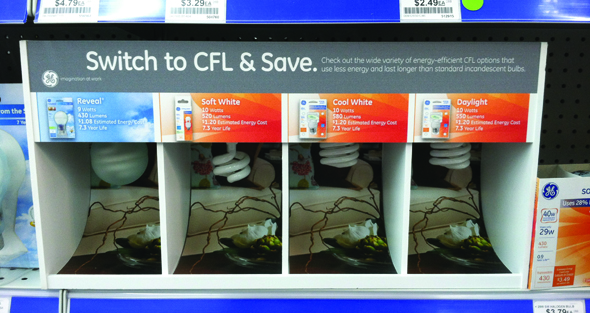The new lead-free plumbing law, the phase-out of incandescent light bulbs: Recently, there have been big changes to the plumbing and electrical categories. Is your store ready?
Parts of the light bulb phase out have already begun but additional deadlines in both categories are rapidly approaching. Now is the time to do a final check of your inventory.
In the plumbing category, these regulations mean there are certain products you can no longer sell at the beginning of 2014. In the electrical category, the influx of new light bulb technologies replacing incandescent means, in addition to inventory changes, you need employees trained to sell those items.
As retailers who have already started implementing these changes can attest, success involves not only paying careful attention to making the changes to inventory, but also educating employees so their product knowledge is up to date.
Lead-Free Plumbing
If you’re like most retailers, you’ve already started working to get your inventory in compliance with the new lead-free plumbing law which takes effect Jan. 4, 2014. Most retailers say valve stems, particularly for obscure or obsolete faucets, and other slow-moving items will be what they’ll most likely cart off to the scrap yard at the beginning of the year. However, if you’re not careful, you’ll be stuck with a lot of items you can’t sell. Remember, any product that does not comply with the lead-free plumbing law cannot be sold or installed after Jan. 4, 2014. Here are three ways to make the transition smooth.
Mark your merchandise
One challenge of the transition, says Ken Walchak, co-owner of Clark-Devon Hardware in Chicago, has to do with rotating out old stock while keeping bins full. For example, compliant and non-compliant fittings usually look the same except for their SKU numbers. While it’s important to keep the bins full, it could be easy to keep restocking the bin with new lead-free product without rotating out the high-lead items.
Walchak and his staff put together a plan to mark all non-compliant items so they know which to sell first and make sure they sell by Jan. 4.
“It is important to identify high-lead items so you sell out those items first and don’t keep filling up the bin without getting rid of the old items first,” he says. “We put a small green dot on all the non-compliant items, so we know what to sell first. It was a gigantic task, but we went through the plumbing department bin by bin, labeling items.”
Review your automated ordering system
Along with labeling items in your bins, check your automated ordering system, if you use one. If non-compliant products are still in your system, make sure you clear all those SKUs and replace them with new compliant SKUs.
Walchak compares the process to what grocers do regularly as they keep an eye on date labels to keep the food they sell fresh. “You have to rotate stock and sell out of the old items,” he says.
Change your prices now
More than likely, when the new lead-free plumbing law goes into effect, most consumers won’t notice much of a difference in the products they buy. What they might notice, however, is the price difference.
In fact, Walchak says prices on some items may be up as much as 30 percent because it’s more difficult to manufacture plumbing fittings without lead. Fortunately, most of the items affected by the law are items with low price sensitivity. “Overall, I think the price difference will be invisible to the customer,”
he says.
Charlie Smith, hardware manager at PC Lumber and Hardware in Sellersburg, Ind., agrees. He started the transition to lead-free products last year. “I’ve not had retail customers ask about it. They don’t seem to be aware of the situation,” he says. “If they noticed anything, it was that we updated our products and are keeping current with the industry.”
Especially if you mix compliant and non-compliant items in the same bin, you might want to start adjusting prices now to get customers acclimated to the new costs.
Light Bulbs
Until recently, most customers didn’t need a lot of help buying a light bulb. In fact, since selling a light bulb required a low level of customer service, retailers of all types, including gas stations, grocery stores and dollar stores, sold basic bulb types as a convenience.
But as new federal efficiency standards continue to phase out traditional incandescent bulb and manufacturers develop new light bulb technologies, consumers have many more choices, and a lot of questions, about the type of bulbs they buy. It’s not the grab-and-go category it used to be.
This is the opportunity for your store to become a light bulb destination. Become the local light bulb expert and create displays in your store that help customers make the best purchases.
Use comparison displays
The best way to help customers make light bulb purchases is to compare and contrast the different types. Many retailers have working displays that show different types of bulbs next to each other. For example, a display might show an incandescent bulb next to a CFL.
Customers can see how the two compare in terms of brightness and color. Part of your demonstration should also be a comparison of the cost to operate each.
Smith, emphasizes the differences in lighting choices by using color samples from his paint department. “We can grab a color swatch, put that in the customer’s hand and show them how the color changes when they hold it up to different lights,” he says. “That really opens their eyes as to the differences between light bulbs.”
Another effective tool is a chart comparing characteristics of incandescent bulbs to those of newer bulb types.
For example, in years past, consumers chose a light bulb based on wattage. While that was actually an indication of how much energy a bulb used, many consumers used it as a measure of how bright the bulb would be. To help customers understand that lumens are actually the correct measurement, keep a chart handy that shows the lumens produced by typical incandescent bulbs. Ask your light bulb vendor for a chart or find a sample one at lumennow.org.
Have a plan to sell through discontinued bulbs
Rather than leave out-of-regulation bulbs on the shelf and wait for the space on the shelf to empty, move them to a bargain bin or special area of the store where you can sell through them quickly.
Smith reset his entire lighting area earlier this year to include only bulbs that were compliant with the new energy regulations. After the reset, his next task was to sell through all the remaining discontinued bulbs. He didn’t have much trouble clearing out the standard incandescent bulbs—many consumers stocked up on those when they heard they would soon no longer be able to buy them. But specialty incandescent bulbs were slower movers.
“After the reset, we put all the out-of-regulation bulbs in a bin and started a structured discount to move them out,” he says. “We started with 10 percent off, then bumped it up to 20 percent and so on. Now we’re up to 70 percent off on the remaining bulbs.”
Do your research, frequently
Where before you might have thought you knew everything there was to know about light bulbs, rapid advances in bulb technology make this a category where you need to stay continually informed.
“We spent a lot of time up front training our staff before the conversion took place,” says John Rot, owner of Horton’s Ace Hardware in LaGrange, Ill., “but it doesn’t stop there. Light bulb technology continues to evolve as manufacturers develop new solutions.” LEDs, for example, seem to change almost weekly, he notes, as manufacturers continue to perfect the features of these types of bulbs. “It’s a moving target, and you have to stay in front of it and keep up with those changes,” he says.
Offer an option for safe bulb disposal
CFL bulbs contain mercury, and many consumers realize disposing of them improperly can harm the environment. Contact your local government agency to find out what it takes to become a recycling drop-off point for bulbs containing hazardous materials like mercury. Having a bin to collect these bulbs doesn’t require much floor space and will enhance your image as being environmentally responsible while being a convenience to your customers.
Learn the lingo
The packaging on light bulbs is now standardized to make it easier to compare different types of bulbs. Explaining the “Lighting Facts” label on each bulb package is essential to help consumers make a purchase decision. Learning the terms and how to translate them into benefits for the customers is essential to employees’ product knowledge training. You also need this information to overcome many of the common objections to buying some of the new types of light bulbs, which include questions about brightness, color and cost. For a training tool from the Alliance to Save Energy, click here.
Talk about tax deductions
Time is running out, but there still may be time for businesses to take advantage of the Energy Efficient Commercial Building Tax Deduction. The current deadline for this deduction is Dec. 31, 2013, and it is available to building owners and tenants making certain energy-saving upgrades to their buildings.
If you have commercial customers who haven’t yet made the switch to energy-efficient lighting systems, remind them of the upcoming deadline, then be ready to supply them with the products to make the upgrade. More information on the deduction is at www.lightingtaxdeduction.org.
 Hardware Retailing The Industry's Source for Insights and Information
Hardware Retailing The Industry's Source for Insights and Information






